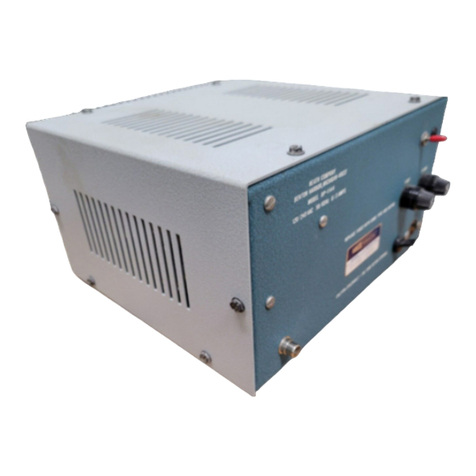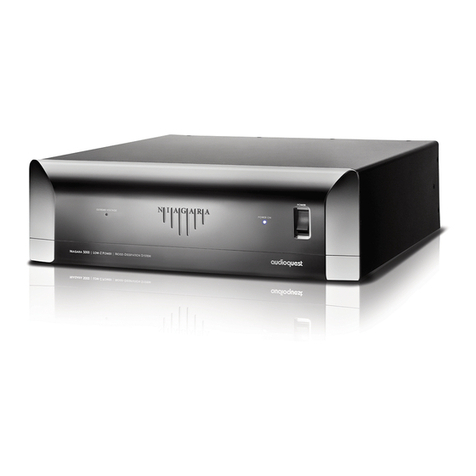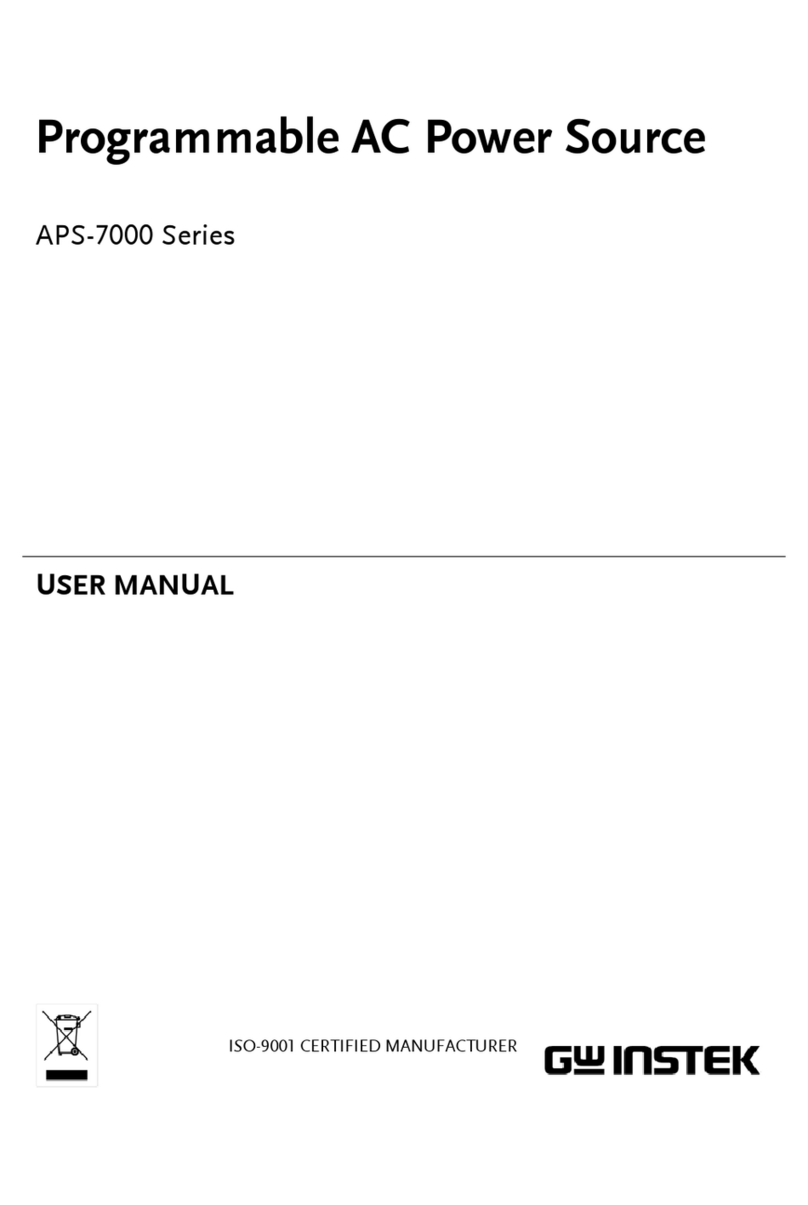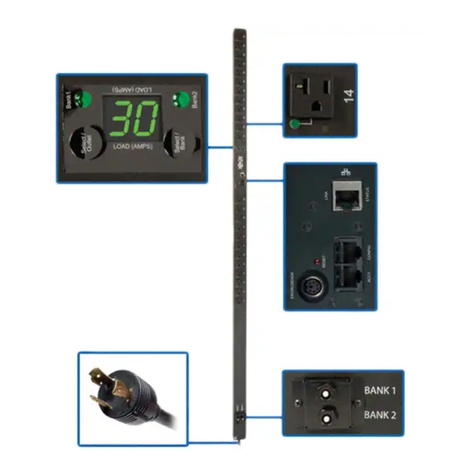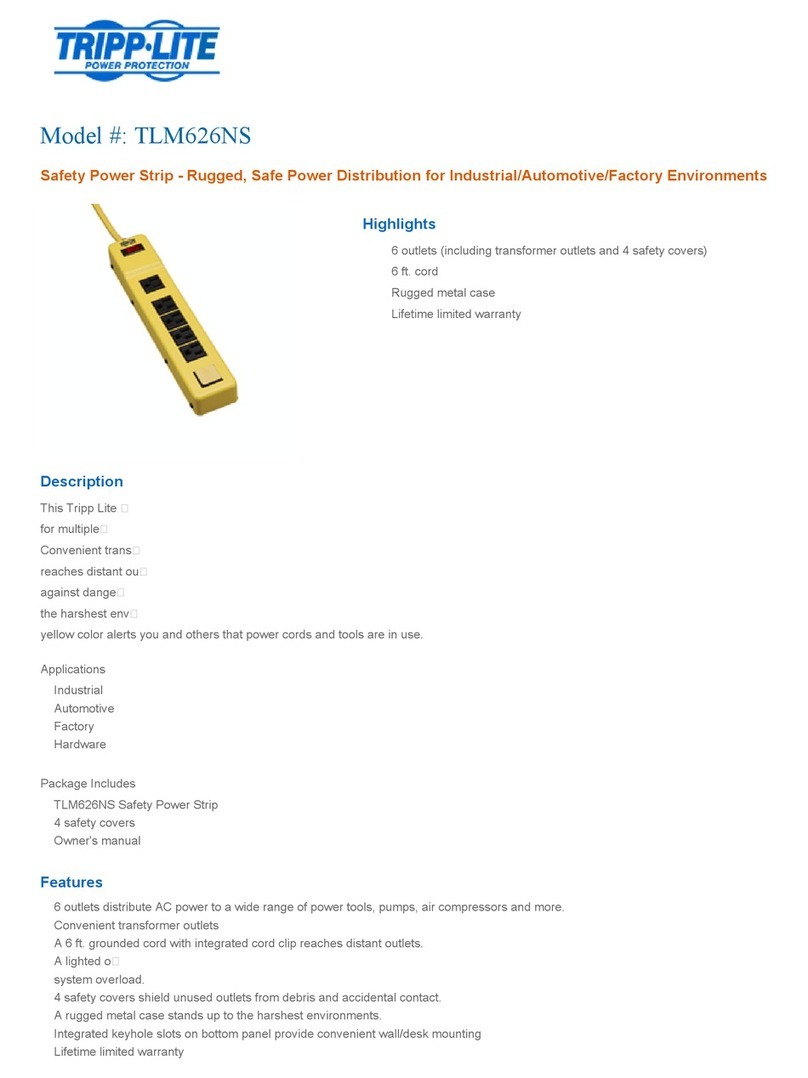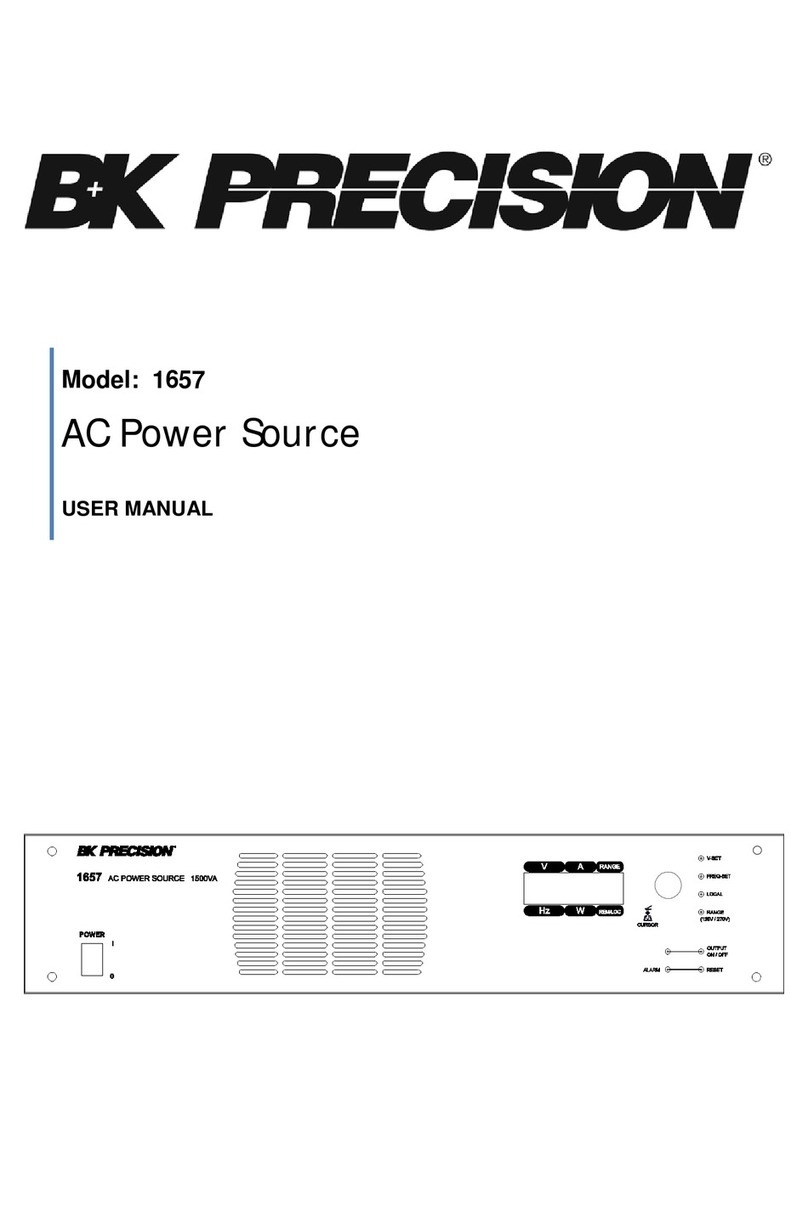Macro Sensors LVC-2500 User manual

User Manual
LVC - 2500
Low Voltage Conditioner
Manual Part No. 0653 0003 0000 Rev B

Index
Index
Manual Part No. 0653 0003 0000 Rev B
1.0 Safety Information 2 4.0 MATH Functions 18
1.1 Electrostatic discharge 3 4.1 MATH Introduction 18
4.2 MATH Set-up Procedure 19
2.0 Installation 4
2.1 Mounting and Access 4 5.0 Transducer Sensitivity 20
2.2 Connections and Link Identification 5 5.1 X2, X5 and DIV2 Link 20
2.3 Description of Links 6
2.4 Primary Frequency 7 6.0 Application 21
2.5 Transducer Input Load 7 6.1 Application Example 21
2.6 Bandwidth 7
2.7 Basic Configuration 8 7.0 Specification 22
2.8 Output Descriptions 9 7.1 Mechanical Outline 22
2.9 Connections 10 7.2 Technical Specification 23
2.10 Placement and EMC 11
2.11 LVC Synchronization 14
3.0 Setting Up 15
3.1 Set-up Summary 15
3.2 Set-up Procedure 16
1

1.0 Safety Information
1.0 Safety Information
2Manual Part No. 0653 0003 0000 Rev B
WARNING statements identify conditions or
practices that could result in personal injury or loss of
life.
CAUTION statements identify conditions or practices
that could result in damage to the equipment or other
property.
Terms in this Manual
This symbol indicates where applicable
cautionary or other information is to be
found.
Symbols in this manual
WARNING: Do not operate in an explosive atmosphere
WARNING: Safety critical environments
This equipment is not intended for use in a safety critical
environment
CAUTION: Low voltage
This equipment operates at below the SELV and is
therefore outside the scope of the Low Voltage Directive.
This equipment is designed to work from a low voltage
DC supply. Do not operate this equipment outside of
specification.
Warnings & Cautions

1.0 Safety Information (cont.)
1.0 Safety Information (cont.)
3Manual Part No. 0653 0003 0000 Rev B
1.1 CAUTION: Electrostatic Discharge
This equipment is susceptible to electrostatic discharge
(ESD) when being installed or adjusted, or whenever the
case cover is removed. To prevent ESD related damage,
handle the conditioning electronics by its case and do not
touch the connector pins.
During installation, please observe the following
guidelines:
Warnings & Cautions
• Ensure all power supplies are turned off
• If possible, wear an ESD strap connected to
ground. If this is not possible, discharge yourself by
touching a metal part of the equipment into which
the conditioning electronics is being installed
• Connect the transducer and power supplies with the
power switched off
• Ensure any tools used are discharged by contacting
them against a metal part of the equipment into
which the conditioning electronics is being installed
• During setting up of the conditioning electronics,
make link configuration changes with the power
supply turned off. Avoid touching any other
components
• Make the final SPAN and ZERO potentiometer
adjustments with power applied, using an
appropriate potentiometer adjustment tool or a
small insulated screwdriver

2.0 Installation Manual Part No. 0653 0003 0000 Rev B
2.0 Installation
4
Before mounting the LVC, please refer to section 2.10.
Hook the LVC on the DIN rail with the release clip facing down and push onto the rail until a ‘click’ is heard.
To remove, use a screwdriver to lever the release clip down. Pull the bottom of the housing away from the rail and unhook.
To access internal links, the front cover and PCB must be withdrawn from the housing. Use a screwdriver or similar tool to
depress the top latch. The cover will spring forward. Repeat with the bottom latch, then gently pull the PCB out.
2.1 Mounting and Access
DIN Rail Withdraw PCB
12 43
Cover Release Latch

2.0 Installation (cont.)
2.0 Installation (cont.)
5Manual Part No. 0653 0003 0000 Rev B
2.2 Connections and link identification
Terminals 5, 11, and 15 are internally connected but, for best performance, they should be treated as
separate terminals.
• Coarse Offset
• Coarse Gain
• Bandwidth
• Null at set-up
• Math
• Input Load
• Input Gain
• Primary Frequency
• Synchronization
Transducer
1 Synchronization 1
2 Synchronization 2
3 Primary
4 Primary
5 Shield (0 V)
6CT
7 Secondary
8 Secondary
Power Supply & Outputs
9 Voltage Output
10 Math OUT
11 Gnd 0 V
12 Current OUT
13 Math External IN
14 Inverted Math OUT
15 –VE power supply
(Gnd)
16 +VE power supply
POWER
SPAN
ZERO

2.0 Installation (cont.)
2.0 Installation (cont.)
6Manual Part No. 0653 0003 0000 Rev B
The table below and subsequent diagrams explain the link functions and detail the factory settings.
2.3 Description of links
Link Description Options Factory Setting
COARSE GAIN Select coarse output gain Range 1 to 6 Link ON, position 1
COARSE OFFSET Select coarse output offset +VE, -VE, 5 V, 10 V No offset, links PARKED
NULL Used during set-up to null output Output in null state or enabled Link PARKED, output enabled
PRIMARY Select primary frequency 3 kHz, 5 kHz, 10 kHz Both links ON, 3 kHz
MT Select synchronization mode Master or track Set as master
INPUT LOAD Select transducer secondary load 100 kΩor 2 kΩLink PARKED, 100 kΩ
INPUT GAIN Input gain X1, X2, X5, DIV2 Link ON, X1
BW Sets output signal bandwidth L = 250 Hz, H = 500Hz Link ON, 250 Hz
MATH Enables math option A+B, A-B, (A+B)/2, (A-B)/2 Links PARKED, maths not set
Note: If the output polarity is incorrect, reverse the transducer secondary connections.
Link ON Link PARKED Link OFF

The LVC primary frequency is set using links as shown below. Transducer specifications determine the optimum frequency.
2.0 Installation (cont.)
2.0 Installation (cont.)
7Manual Part No. 0653 0003 0000 Rev B
2.4 Primary Frequency
Primary amplitude is not adjustable. The LVC
uses ratiometric techniques and is insensitive
to primary amplitude. Maximum secondary
transducer amplitudes must be observed.
Refer to section 5.1.
The LVC has two input load ranges. 100 kΩis often used for
LVDT transducers while 2 kΩis often used for Half Bridge
transducers. If loads of less than 100 kΩare required, an
external resistor may be wired across the SEC1 and SEC2
terminals. Most transducers perform well into 100 kΩ. See
specification section 7.2 for further details.
100 kΩ- link PARKED
2 kΩ- link ON
2.5 Transducer Input Load
The LVC has selectable bandwidth (BW). The bandwidth
setting is independent of other LVC settings. Where
possible, the lowest bandwidth setting should be used to
minimize output noise.
250 Hz - Link ON
500 Hz - Link PARKED
Note: Total system bandwidth is dependent on sensor
type and application
2.6 Bandwidth
3 kHz 5 kHz 10 kHz
1
2
3
4
1
2
3
4
1
2
3
4

2.0 Installation (cont.)
2.0 Installation (cont.)
8Manual Part No. 0653 0003 0000 Rev B
2.7 Basic Configuration
Please refer to section 2.10 before installation.
A floating output power supply is recommended
as it will minimize ground loop noise problems.
Please refer to section 6.1
for a typical arrangement.
Voltage and current
connections are shown.
Generally only one type
is used.

+
-
2.0 Installation (cont.)
2.0 Installation (cont.)
9Manual Part No. 0653 0003 0000 Rev B
2.8 Output Descriptions
This section describes how the various
outputs of the LVC are related.
Vout This is a voltage output. The gain and offset controls are used to set the required
output range. All other outputs are affected by changes made to Vout.
Iout This is a current output only, LVC is not loop powered. This can be set for up to ±20
mA. A common output is 4-20 mA. The Iout is proportional to Vout but cannot be
independently adjusted. The approximate relationship is shown below:
Voltage (V) -10 -8 -6 -4 -2 0 2 4 6 8 10
Current (mA) -20 -16 -12 -8 -4 0 4 8 12 16 20
When relating current to voltage, 4-20 mA is the same as a 2 to 10 V span (or ±4 V
with a +6 V offset).
Mout Mout is the main MATH output. This is a voltage output. Vout and Min are combined
in the MATH section. The output of this section is inverted to keep the signal
polarity the same as Vout.
Mout# This is an auxiliary voltage output. This is the direct output of the MATH stage
and is the inverse of Vout. If MATH options are not selected then Mout ∝Mout# ∝
Vout. Refer to section 4.1.
All outputs may be used at the same time but cannot be independently adjusted for span or zero.
Input Gain Coarse Gain SPAN
Transducer
Circuits
Offsets
Vout
Iout
Mout#
Mout
-1
-1
I ∝V
Min
MATH
and ZERO

2.0 Installation (cont.)
2.0 Installation (cont.)
10 Manual Part No. 0653 0003 0000 Rev B
2.9 Connections
The diagram in section 2.7 shows a basic connection with LVDT. The following diagram gives further details of Macro Sensors
LVDT transducers and alternative connections for Half Bridge transducers.
Terminal 6 is provided only as a convenient point for termination of the center tap (CT) if one is present. There is no actual need
for a connection to Terminal 6, as it is not connected to anything within the LVC. A center tap connection is not necessary for
LVDT
0V
(GND)
3
CT (blu & grn B&C)
Pri2 (brn F)
Pri1 (yel E)
Sec1 (red A)
Sec2 (blk D)
4
7
8
6
5
Half-Bridge
0V
(GND)
Low
High
Mid-Tap
3
7
8
4
6
5
CT
proper operation of the LVC.
NOTE:
See note below See note below

2.0 Installation (cont.)
2.0 Installation (cont.)
11 Manual Part No. 0653 0003 0000 Rev B
2.10 Placement and EMC
The LVC has been designed to comply with EMC regulations. For best performance, the EMC compliance of surrounding
equipment must be considered. High levels of EMI (electro magnetic interference) can affect the performance of LVC.
Residential, Commercial and Light Industrial Environments
Typically this will be an office, laboratory or industrial environment where there is no equipment likely to produce high levels
of electrical interference such as welders or machine tools. Connections may be made using twisted pair wire which is a cost-
effective option giving good performance in this environment. Standard equipment wire (24AWG) can be twisted together as
required. Standard data cable such as a generic CAT5 UTP will also give good performance.
Industrial Environments
Typically this will be an industrial environment where there is equipment likely to produce high levels of electrical interference
such as welders, large machine tools, cutting or stamping machines. The LVC should be mounted inside an industrial steel
enclosure designed for EMI shielding. Many enclosures, though metal, are not designed for shielding and so careful installation is
important. Place the LVC away from equipment within the enclosure that is likely to produce high levels of EMI.
Connections should be made using a shielded cable (braided or foil schielded cables may be used). The cable shield should
be connected to the housing at the cable entry point. An EMC cable gland is recommended. If this is not possible, then the
unshielded section of cable should be kept as short as possible, and the shield should be connected to a local ground.
Where possible, the LVC should be the only ground connection point. If voltage, current or power supplies are ground referenced
and connected at some distance from LVC, then noise may be introduced.
All Gnd terminals on LVC are connected internally. Only one local ground is needed for each LVC.
A local power supply is ideal but, if this is not possible, a shielded cable arrangement can be used to reduce noise picked up.

2.0 Installation (cont.)
2.0 Installation (cont.)
12 Manual Part No. 0653 0003 0000 Rev B

2.0 Installation (cont.)
2.0 Installation (cont.)
13 Manual Part No. 0653 0003 0000 Rev B

2.0 Installation (cont.)
2.0 Installation (cont.)
14 Manual Part No. 0653 0003 0000 Rev B
2.11 LVC Synchronization
When a system comprises several LVC modules, it is possible to synchronize primary oscillator signals. Synchronization will
not be required for most installations. It is only required when transducers and their cables are installed in close proximity to
each other and there may be electrical interaction or cross-talk between sensors. This may be seen as a change in output from
one module when the sensor connected to an adjacent module is moved. Even when sensors are installed close to each other,
synchronization may not be required as cable shielding is generally effective. If interactions are seen, the cause is often poor
ground or shield connection or mechanical effects between sensors when mounted together.
PCB Idents
M T
5 10 13
1
2
3
4
Link Positions
(Primary links not shown)
3 5 10
MASTER TRACK

3.0 Setting Up
3.0 Setting Up
15 Manual Part No. 0653 0003 0000 Rev B
3.1 Set-up Summary
This is a set-up summary. A more detailed procedure is included in following sections but these simple steps describe a typical
setting procedure and apply to most applications. Other procedures may be used as appropriate.
Step 1 Step 2 Step 3 Step 4 Step 5
Set links as required* • Set LVC output to zero • Move transducer to
full scale position • Add offset if required • Final checks
• Mechanically align
transducer null • Set LVC coarse gain
and SPAN • Set LVC coarse offset
and ZERO • Repeat steps 2 - 4
to check setting
Primary frequency
Transducer load
Initial gain
Bandwidth
No offset*
No MATH* 9
*If in doubt about initial link position, use the factory setting. Performing initial set-up without offset and MATH options makes
set-up easier.
For a bi-polar output i.e. ±10 VDC or ±20 mA, follow steps 1 to 3.
For a uni-polar output i.e. 0-10 VDC, 0-20 mA or 4-20 mA, follow steps 1 to 4.
In either case, step 5 (final checks) should be followed to complete the set-up.
Null
Zero
transducer
electronics
Zero
-5V +5V
Null
electronics
transducer
Null
+5V0V +10V
electronics
transducer
Shift
zero

3.0 Setting Up (cont.)
3.0 Setting Up (cont.)
16 Manual Part No. 0653 0003 0000 Rev B
Step 1 - Set-up LVC links
If the transducer characteristics are known, set the frequency and input resistance links as required. If the transducer
characteristics are not known, the factory default link settings should be used.
If the transducer is known to be outside the standard sensitivity range, the X2, X5 or DIV2 links will have to be used. Please
refer to section 5.1
Step 2 - Mechanically align LVC and transducer null
Any electrical offset in the LVC is removed. The transducer core position is adjusted so that transducer and LVC nulls are
aligned.
Null the LVC
1Move the coarse gain link jumper to the NULL position. This puts a temporary short across the
transducer input and allows any electronics offset to be removed
2 Adjust the ZERO control to give as near zero electrical output as practical
Null the transducer
3Move the coarse gain link jumper from NULL back to its original position
4 Adjust the position of the transducer core to give as near zero electrical output as practical.
This is the center of the mechanical range
If the transducer cannot be centered for practical reasons, an offset will remain within the system. There may be noticeable
interaction between SPAN and ZERO adjustment. This does not prevent the LVC being set-up, although several iterations may be
required when adjusting SPAN and ZERO.
COURSE GAIN
6 5 4 3 2 1
NULL
BWL
H
3.2 Set-up Procedure
COARSE GAIN

3.0 Setting Up (cont.)
3.0 Setting Up (cont.)
17 Manual Part No. 0653 0003 0000 Rev B
Step 3 - Setting bi-polar (±) full scale output
1 Move the transducer core to the position where maximum LVC output is required
2 If the output polarity is wrong, reverse the transducer primary connections (terminals 3 & 4). Move the transducer core back and
re-check the zero position
3 Move the coarse gain link along from position 1 towards position 6 until the LVC output is near the required value
4 Adjust the SPAN control to give the required output
5 The bi-polar output is now set. Proceed to step 5
If a uni-polar output is required proceed to step 4.
Example: ±10 V is required from a ±1 mm transducer. Set the transducer core at the +1 mm position and set the output to +10 V.
Step 4 - Setting uni-polar full scale output (adding an offset)
1 Move the transducer core to the null position. LVC output will be 0 V or 0 mA
2 Apply offset using the +VE, -VE, 5 V and 10 V links and adjust the ZERO control to set precisely. Both links may be used to give
greater offset shift. Proceed to step 5
Example: 0-10 V is required for a ±1 mm transducer. Set the transducer core to give ±5 V over the full range and then, with the
transducer core at null, add +5 V offset. Adjust the ZERO to give 5 V. When the transducer core is moved to the +1 mm position,
the output will be +10 V.
Example: 4-20 mA is required for a ±1 mm transducer. Set the transducer to give ±8 mA over range and then, with the transducer at
null, add +5 V (≈10 mA) offset. Adjust the ZERO to give +12 mA. When the transducer core is moved to the +1 mm position, the
output will be +20 mA.
Step 5 - Final checks
Ensure that calibration is correct by moving the transducer core through the required mechanical range (including the mid position)
and checking the calibration points. Fine adjustments can be made if required.
It may only be possible to set the output accurately at the two calibration points. This is due to non-linearity within the transducer.

Power
Supply
15
16
3
7
8
4
6
50V
(GND)
Output
11
9
12
0V
(GND)
1 2
Math
Transducer
10
14
13
Min
Mout
Mout#
Min
Mout
Mout#
Vout
Iout
Vout
Iout Transducer
B
Transducer
A
V
+
-
Power
Supply
15
16
3
7
8
4
6
50V
(GND)
Output
11
9
12
0V
(GND)
1 2
Math
Transducer
10
14
13
4.0 MATH Functions
4.0 MATH Functions
18 Manual Part No. 0653 0003 0000 Rev B
4.1 MATH Introduction
By linking two LVC modules, the following analog arithmetic may be performed: A+B, A-B, (A+B)/2 and (A-B)/2.
The output of LVC A, VoutA, is connected to the Min terminal of LVC B. The output of LVC B is routed internally to the arithmetic
circuits and the result is available at the Mout terminal.
The inverse of Mout is available as Mout#. Vout, Mout and Mout# may be used at the same time, however they are not
individually adjustable.
LVC A
No MATH link
setting required
Vout ∝transducer A
position
Mout = Vout
Mout# = 1/Mout =
1/Vout
LVC B
Math links set as
A-B (example)
Vout ∝transducer B
position
Mout = VoutA- VoutB
Mout# = 1/ Mout

4.0 MATH Functions (cont.)
4.0 MATH Functions (cont.)
19 Manual Part No. 0653 0003 0000 Rev B
Setting up two LVC for MATH can become confusing as the output of each LVC will affect the final output. The steps below are
guidelines to help the set-up process.
Step 1 - Requirements
Write down the arithmetic required and the range of outputs likely to be seen. This will allow the requirement for each
individual LVC to be determined. Vout of each LVC is used.
Example: ±10 V required for A-B.
If each LVC is set to ±10 V, then A-B would calculate to be ±20 V. However, as this is not possible, each LVC must be set to ±5 V
or use ±10 V (A-B)/2.
Example: 0-10 V required for A+B.
Set each LVC for 0-5 V or set each LVC to 0-10 V and use (A+B)/2.
Step 2 - Initial set-up
Set up each LVC as an individual module first.
Working around transducer null and having a ±V output will make set-up easier.
Step 3 - Final checks and further comments
Initially each LVC Vout may have been set to an accurate zero but an offset may still be seen at Mout. This is because of
offsets inherent within the MATH circuits. To remove this offset, adjust one of the Vout offsets. Mout offset adjustment is best
performed on the LVC set for MATH.
1
2
3
4
A+B A-B
LINK FOR
(X)/2
1
2
3
4
1
2
3
4
1
2
3
4
1
2
3
4
1
2
3
4
4.2 MATH Set-up Procedure
A+B A-B (A+B)/2 (A-B)/2 Mout=Vout
Table of contents
